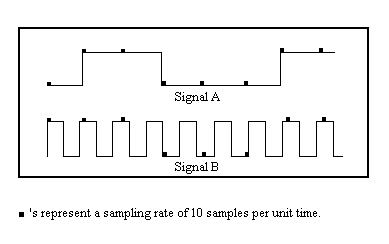 12.5. Aliasing
12.5. Aliasing  12.5. Aliasing
12.5. Aliasing Aliasing occurs when one screen pixel corresponds to several different texels. This usually happens where the texture map is compressed by the processes of surface parameterization and screen projection. Due to limitations in screen resolution some amount of surface detail will be lost. Deciding on the frequency (colour) displayed by the pixel, or how the composite texels will affect that frequency, can greatly affect the quality of the image.
For example, a textured surface is sampled at discreet
intervals to obtain values for each pixel, as shown in the
following diagram. The squares denote where the signals are
sampled. Let us say that Signals A and B represent frequency
variations on two different surfaces. When samples of the
signals are taken, the resulting variations in frequency seen on
the screen are the same for both surfaces despite the obvious
real difference. In this example Signal A becomes an "alias" of
signal B. As a result a few broad strips are displayed rather
than a group of closely spaced lines (Crow, 1981).

Alliasing presents less of a problem when high resolution displays are used, since the number and frequency of sampling points is greatly increased. This means that variations in surface colour are more likely to be noticed and able to be displayed. However sufficiently high resolution displays are impractical in terms of hardware costs so we seek to find other ways to reduce the effects of aliasing.












